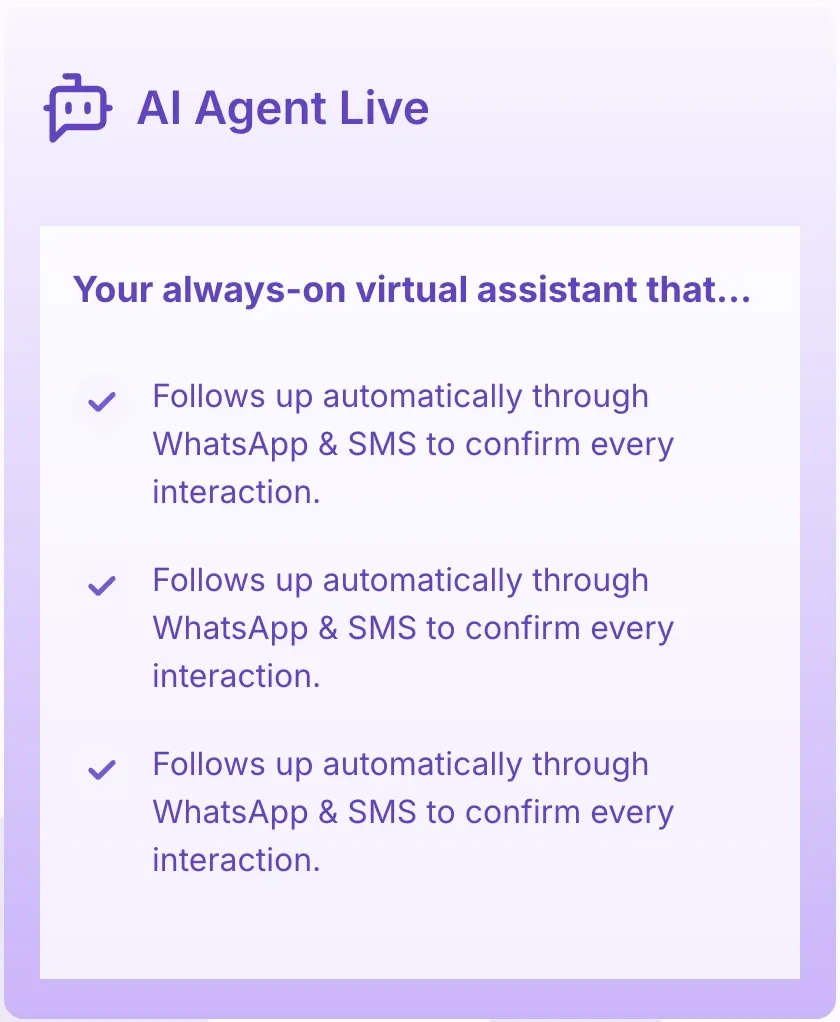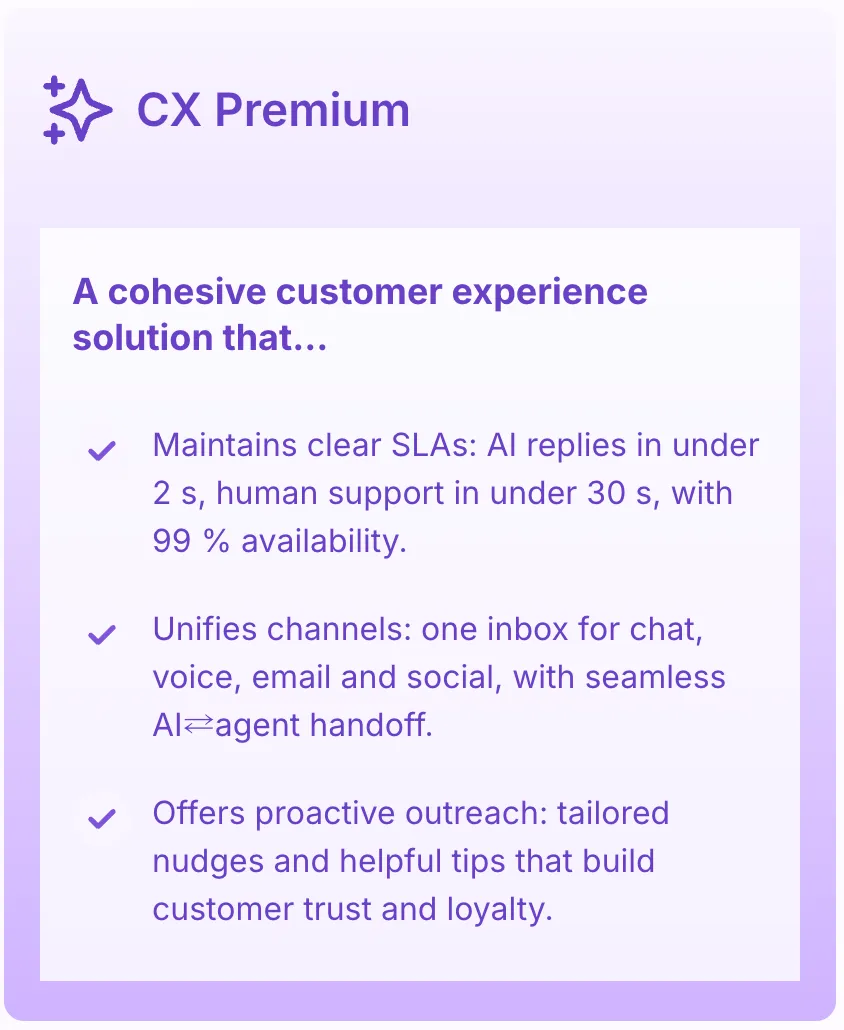Recent data from McKinsey reveals that 78% of organizations now use AI in at least one business function. This rapid adoption is reshaping customer expectations across every industry. When customers experience seamless AI-powered interactions with Netflix or Amazon, they expect the same level of service from your business.
The stakes are higher than ever. Gartner predicts that by 2029, agentic AI will autonomously resolve 80% of common customer service issues. This shift presents both opportunities and challenges:
- Balancing automation efficiency with authentic human connection
- Meeting elevated customer expectations across multiple channels
- Creating memorable experiences that drive loyalty
- Maintaining emotional intelligence in AI interactions
This article reveals how leading companies are mastering these challenges. You'll discover new satisfaction metrics for 2025, proven ROI frameworks for AI investments, and strategic actions to stay ahead of your competition.
Is your business ready to transform customer satisfaction from a metric into a sustainable competitive advantage? Let's explore the psychological, technological, and economic factors that will determine success in this new era of customer service.
Understanding Modern Customer Satisfaction Dynamics
Customer satisfaction has two main parts: functional satisfaction and emotional satisfaction. Functional satisfaction looks at how well a product or service meets basic needs, while emotional satisfaction focuses on how the experience makes customers feel. Both aspects together create a complete picture of satisfaction that leads to loyalty and repeat business.
The Psychology Behind Modern Customer Experience (CX)
Maslow's hierarchy of needs, when applied to customer experience, shows us why just meeting basic service functionality isn't enough:
- Basic Needs: System uptime, accurate transactions
- Safety Needs: Data security, reliable service
- Belonging: Personalized interactions, community engagement
- Esteem: VIP treatment, recognition programs
- Self-Actualization: Brand alignment, shared values
Cognitive Load Theory in Customer Experience
Your customers are dealing with more and more complexity in their service interactions. Cognitive Load Theory tells us that satisfaction decreases as mental effort increases. Here are the key factors that affect cognitive load:
- Number of steps to complete a task
- Information density per interaction
- Decision complexity
- Context switching between channels
The Peak-End Rule
Daniel Kahneman's research reveals that customers judge experiences based on two key moments:
- The peak intensity (highest emotional point)
- The ending
This psychological principle shapes how service interactions should be designed:
- Create positive peak moments during critical handoffs
- Ensure strong closure in issue resolution
- Focus resources on emotionally significant touchpoints
- Design memorable positive experiences at key decision points
Practical Application
Your satisfaction strategy must consider both psychological frameworks:
- Reduce cognitive load through simplified interfaces
- Create emotional high points in customer journeys
- Design positive endings for every interaction
- Build experiences that progress through satisfaction hierarchy levels
- Measure both functional and emotional satisfaction metrics
Smart companies use these psychological insights to create experiences that connect with customers on both rational and emotional levels, leading to stronger brand loyalty.

The Competitive Edge of AI-Enabled Customer Satisfaction
AI has changed the game when it comes to customer service. It has raised the bar by providing highly personalized experiences on a large scale. Companies that use AI-powered systems have a significant advantage in anticipating and fulfilling customer needs even before they are expressed.
Netflix's Recommendation Engine: A Prime Example
Netflix's recommendation engine is a perfect illustration of this competitive advantage. Here's how it works:
- It analyzes viewing patterns to suggest content tailored to each individual.
- It rearranges the order of rows based on personal preferences.
- It takes into account the time of day to recommend shows or movies.
- As a result, Netflix estimates that personalization through this engine brings in an additional $1 billion every year by retaining customers who might otherwise cancel their subscriptions.
Amazon's Predictive Shopping: Raising the Bar Even Higher
Amazon, on the other hand, has taken things a step further with its predictive shopping features. Here's what they offer:
- Anticipatory shipping: Based on past purchase behavior, Amazon can predict what items customers are likely to buy next and ship them in advance to ensure quick delivery.
- Smart reordering suggestions: For products that are frequently bought or consumed, Amazon uses AI algorithms to analyze usage patterns and proactively suggests reordering at the right time.
- Personalized product recommendations: By leveraging machine learning techniques, Amazon tailors product suggestions for each customer based on their browsing history and preferences.
- Price optimization: Through dynamic pricing strategies powered by AI, Amazon adjusts prices in real-time based on demand fluctuations and competitor actions.
The Future of Customer Service: Agentic AI
According to research conducted by Gartner, there is an impending transformation in customer service. They predict that by 2029, agentic AI will autonomously handle 80% of common customer service inquiries. This projection underscores the urgent need for businesses to embrace AI solutions or risk being left behind by their competitors.
Sentiment-Aware AI: Building Stronger Connections
While predictive capabilities are crucial, creating genuine connections with customers requires understanding their emotions. This is where sentiment-aware AI comes into play:
- Real-time emotion detection: Using natural language processing (NLP) techniques, sentiment analysis algorithms can accurately identify the emotional state of customers during interactions - whether it's happiness, frustration, or confusion.
- Adaptive responses: Based on detected emotions, businesses can tailor their responses accordingly - offering empathy and reassurance during negative experiences or celebrating achievements during positive ones.
- Proactive intervention: When negative sentiments are detected early on, businesses can take immediate action to resolve issues before they escalate - such as routing calls to specialized agents or offering compensation proactively.
- Higher satisfaction scores: Studies show that companies implementing sentiment-aware AI have reported satisfaction scores that are 20-30% higher compared to traditional systems.
The Power of Collaboration Between Humans and AI
While automation plays a vital role in scaling customer service operations efficiently, there are certain situations where human intervention is necessary for delivering exceptional experiences. This is where human-AI collaboration becomes key:
- Routine queries handled by AI: Chatbots powered by artificial intelligence can effectively address common questions like order status inquiries or return policies without involving human agents - freeing up resources for more complex cases.
- Complex cases managed by humans: Issues requiring critical thinking or emotional intelligence (e.g., complaints about product quality) should ideally be handled by trained agents who possess these skills naturally.
- Smooth transitions between AI and humans: In scenarios where handoffs occur between chatbot interactions and live agent conversations (e.g., when a customer requests escalation), clear communication should be established so that customers don't feel frustrated due to repeated explanations.
- Enhanced productivity through assistance: With access to relevant information provided by AI tools (e.g., previous interaction history), human agents can resolve queries faster while ensuring personalized service delivery.
The integration of both technologies allows businesses to strike a balance between efficiency gained through automation and empathy retained via human touch - resulting in improved outcomes across various metrics such as first-contact resolution rates or customer lifetime value.
Benefits Reported by Companies Implementing Sentiment-Aware AI
Several organizations have already begun implementing sentiment-aware AI solutions within their customer service frameworks:
- Reduced churn rates: By identifying dissatisfied customers early on through emotion detection algorithms and taking proactive measures accordingly (e.g., offering refunds), businesses have witnessed lower attrition rates among existing clients.
- Higher first-contact resolution rates: With access to contextual information provided by previous interactions stored in CRM systems integrated with sentiment analysis tools, agents have been able to resolve queries more effectively during initial conversations itself rather than requiring multiple touchpoints.
- Improved lifetime value metrics: Satisfied customers tend not only stay longer but also spend more over time - leading directly towards enhanced profitability figures for businesses adopting these strategies consistently over long periods.
The Role of Intelligent Automation in Customer Service
It’s important to note that while the integration of artificial intelligence (AI) brings numerous benefits such as scalability and efficiency into play; it doesn’t replace humans entirely from the equation.
Instead; it empowers them!
The goal here is not just about automating processes but rather creating intelligent interactions that combine both technology-driven solutions along with genuine human connections whenever required.
This hybrid approach ensures consistency across touchpoints while also allowing flexibility based upon unique circumstances surrounding each interaction type involved therein.
Establishing Leadership Through Exceptional Customer Experiences
Organizations mastering this delicate balance between technological prowess exhibited via automated systems combined alongside heartfelt gestures displayed through personal touches stand poised become industry leaders when it comes delivering unparalleled levels satisfaction amongst clientele base they serve!
New Metrics Shaping Customer Satisfaction Measurement by 2025
Traditional satisfaction metrics like CSAT and NPS fall short in today's AI-driven customer service landscape. These metrics miss crucial elements of modern customer interactions:
- CSAT scores fail to capture the nuanced emotional responses during AI interactions
- NPS ratings don't reflect the quality of human-AI handoffs
- Traditional metrics ignore the complexity of multi-channel customer journeys
The evolution of customer experience measurement demands new metrics that paint a complete picture:
Enhanced Customer Effort Score (CES)
- Measures cognitive load across automated and human touchpoints
- Tracks friction points in AI-human transitions
- Evaluates self-service success rates
Containment Rate Metrics
- Percentage of issues resolved by AI without human intervention
- Quality of AI-provided solutions
- Customer acceptance of automated resolutions
Agent Assist Utilization Index
- Effectiveness of AI suggestions to human agents
- Speed of issue resolution with AI assistance
- Accuracy of AI-recommended solutions
Resolution Quality Index
- First-contact resolution rates across channels
- Customer feedback on solution completeness
- Long-term issue recurrence tracking
These new metrics provide deeper insights into customer satisfaction by measuring both technical performance and emotional resonance in modern service interactions.
Economic Impact and ROI Frameworks for Customer Satisfaction Investments
Calculating ROI for customer satisfaction investments requires a sophisticated approach in today's AI-driven landscape. The traditional ROI calculation models need adaptation to capture the full spectrum of benefits from modern customer satisfaction initiatives.
1. Direct Revenue Impact Metrics:
- Customer Lifetime Value (CLV) increase: 20-30% higher for satisfied customers
- Referral revenue boost: Satisfied customers bring 2.5x more referrals
- Price sensitivity reduction: Loyal customers accept 10% higher prices
2. Cost Reduction Benefits:
- AI automation savings: $3-5 reduction in operational costs per 1% improvement in first-contact resolution
- Decreased escalation rates: 40-60% reduction through unified customer context
- Lower churn-related expenses: 5x cost savings through predictive intervention
3. Risk Mitigation Value:
- Brand reputation protection
- Competitive position strengthening
- Regulatory compliance assurance
The ROI calculation formula for modern customer satisfaction investments:
Total ROI = (Direct Revenue + Cost Savings + Risk Value - Investment) / Investment
A practical example: A $1M investment in AI-driven customer satisfaction improvements can generate:
- $1.5M in increased customer lifetime value
- $800K in operational cost savings
- $400K in risk mitigation value
This creates a 170% ROI while building long-term competitive advantages through enhanced customer relationships.
Budget Allocation Strategies to Outperform Competitors in Satisfaction
Strategic budget allocation drives exceptional customer satisfaction results. The proven 70-20-10 investment framework creates a balanced approach to CSAT improvement:
1. Core Automation Excellence (70%)
- AI system development and maintenance
- Integration infrastructure
- Platform reliability improvements
- Response accuracy optimization
2. Human-AI Collaboration (20%)
- Agent training programs
- Workflow refinement
- Handoff process optimization
- Cross-channel coordination
3. Innovation Projects (10%)
- Emerging technology exploration
- Competitive differentiation initiatives
- Experimental service models
This allocation model delivers measurable results:
- 1% improvement in first-contact resolution = 3-5% reduction in operational costs
- Sentiment-aware AI capabilities = 20-30% higher satisfaction scores
- Unified customer context = 40-60% fewer escalations
- Proactive issue resolution = 5x cost reduction vs reactive support
Smart budget distribution between these three pillars enables organizations to build robust automated systems while maintaining the human touch customers value.

Competitive Benchmarking & Positioning Analysis
Benchmarking your customer satisfaction performance against competitors reveals critical gaps and opportunities in your service delivery. A comprehensive analysis includes three key areas:
1. Direct Competitor Analysis
This involves studying your direct competitors and assessing the following aspects:
- AI response accuracy rates
- Resolution time metrics
- Customer feedback sentiment scores
- Automation capabilities deployment
2. Industry Leader Insights
In addition to analyzing direct competitors, it's essential to gain insights from industry leaders. This includes understanding their:
- Best-in-class satisfaction strategies
- Innovation adoption rates
- Service experience standards
- Technology implementation success rates
3. Your Positioning Matrix
Your positioning matrix should evaluate:
- AI Response Quality: Compare automated response effectiveness
- Human Escalation Success: Measure handoff smoothness rates
- Emotional Connection Scores: Track sentiment analysis results
- Digital Channel Performance: Assess omnichannel capabilities
A data-driven competitive analysis helps identify areas where your satisfaction metrics lag behind market leaders. Companies excelling in customer satisfaction typically demonstrate superior performance in automated issue resolution, seamless channel transitions, and emotional intelligence capabilities. Regular competitive benchmarking enables strategic adjustments to maintain market leadership in customer experience delivery.
Turning Customer Satisfaction into a Sustainable Competitive Advantage
Today's customers shape their service expectations through daily interactions with platforms like Netflix, Amazon, and leading e-commerce sites. These experiences create a new baseline for customer satisfaction across all industries.
Creating a sustainable satisfaction advantage requires:
- Deep Integration: Embedding satisfaction measurement into every customer touchpoint
- AI-Powered Personalization: Delivering Netflix-style predictive experiences
- Seamless Channel Transitions: Matching the fluid experience of mobile banking apps
- Real-Time Adaptation: Learning from customer behavior patterns to enhance service delivery
Companies achieving sustainable satisfaction advantages see compounding benefits:
- Higher-quality feedback data
- Increased customer referrals
- Greater price tolerance
- Reduced churn rates
The key lies in building integrated CX solutions that combine AI capabilities with human touch points. This integration allows companies to scale personalized experiences while maintaining the emotional connections that drive long-term loyalty.

Path Forward: Strategic Actions to Stay Ahead in Customer Satisfaction
Staying ahead in customer satisfaction requires a systematic approach to identifying and addressing service gaps. A comprehensive audit of your current metrics reveals critical insights about your customer experience strategy.
Key Areas for Strategic Auditing:
- Metric Alignment Check
- Compare existing KPIs against actual customer loyalty patterns
- Analyze the correlation between satisfaction scores and repeat purchase behavior
- Track emotional satisfaction indicators in automated interactions
- Automated Environment Assessment
- Measure AI response accuracy rates
- Evaluate containment rates for self-service channels
- Monitor human-AI handoff success rates
- Loyalty Driver Analysis
- Map customer journey touchpoints to satisfaction metrics
- Identify moments of truth in the service experience
- Measure emotional engagement across interaction channels
Your audit results create a data-driven foundation for strategic improvements. Companies that implement regular satisfaction audits see a 25-30% increase in customer retention rates. This systematic approach helps you spot emerging trends, address service gaps, adapt to changing customer needs.
A satisfaction audit template helps standardize your evaluation process:
- Define measurement criteria
- Collect cross-channel feedback
- Analyze satisfaction patterns
- Identify improvement opportunities
- Create action plans with clear ownership
Conclusion
To create a customer satisfaction strategy that will stand the test of time, you need to understand both psychology and economics. Your competitors are already using AI to gain insights and create unforgettable customer experiences that combine emotional intelligence with operational efficiency.
Now is the time to take action. By using psychological concepts such as Maslow's hierarchy and the Peak-End Rule, you can establish stronger connections with your customers that go beyond traditional satisfaction measurements. When you combine these insights with solid economic models, you'll be able to:
- Measure the true return on investment (ROI) of customer satisfaction
- Monitor emotional and functional outcomes
- Build sustainable advantages over your competitors
Your customer satisfaction efforts should go beyond just automating processes. Instead, focus on creating meaningful experiences that resonate with today's consumers. The companies that can successfully balance AI efficiency with a human touch will become leaders in their industries.
Start making changes today. Review your current satisfaction metrics, compare them to your competitors, and develop a comprehensive strategy that transforms customer satisfaction into long-term business growth.
FAQs (Frequently Asked Questions)
Why is customer satisfaction crucial in today's competitive business landscape ?
Customer satisfaction is vital today because it directly influences customer loyalty, lifetime value, and referral rates. In a competitive market, delivering exceptional satisfaction differentiates brands, drives repeat business, and fosters sustainable growth.
How is AI transforming customer service and what challenges do enterprises face ?
AI enhances customer service by enabling predictive, personalized interactions and automating routine tasks. However, enterprises must balance automation with human empathy to maintain emotional connection, ensuring seamless human-AI collaboration without sacrificing quality.
What psychological frameworks influence modern customer experience expectations ?
Frameworks like Maslow’s hierarchy of needs applied to CX highlight the importance of addressing both functional and emotional satisfaction. Cognitive Load Theory emphasizes reducing customer effort, while the Peak-End Rule and Daniel Kahneman's research guide designing memorable positive experiences.
What new metrics are emerging to measure customer satisfaction more effectively by 2025 ?
Beyond traditional CSAT and NPS scores, enhanced metrics such as Customer Effort Score (CES), Containment Rate, and Agent Assist Utilization are gaining prominence. These metrics better capture the quality of automated and human-AI blended customer experiences in modern CX environments.
How can businesses calculate ROI on investments in AI-driven customer satisfaction initiatives ?
ROI calculation involves assessing direct revenue impacts like increased lifetime value and referral uplift from satisfied customers combined with cost savings from AI automation. Integrating human-AI workflows maximizes efficiency while preserving service quality for optimal returns.
What budget allocation strategies help companies outperform competitors in improving customer satisfaction ?
An effective budget model allocates approximately 70% towards core automation reliability to ensure consistent service, 20% towards optimizing human-AI collaboration for empathy and personalization, and 10% towards innovation projects that differentiate the customer experience.









